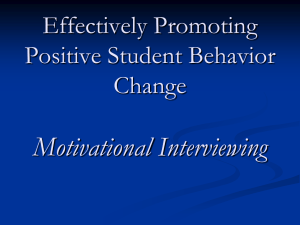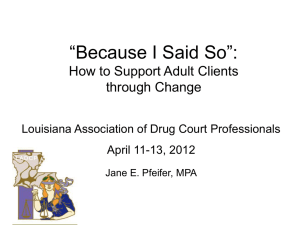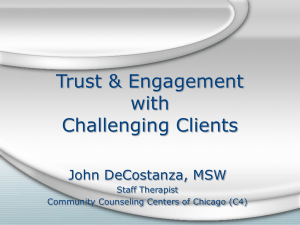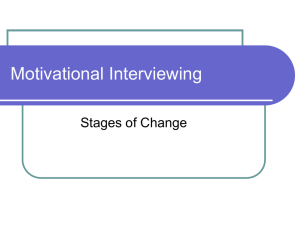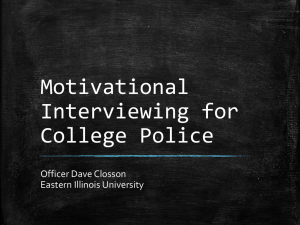Motivational Interviewing (MI)
advertisement
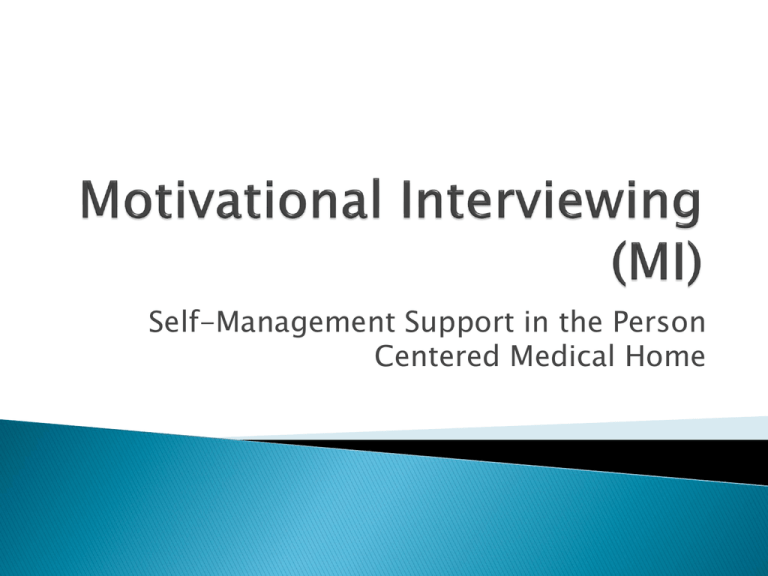
Self-Management Support in the Person Centered Medical Home A person-centered directive method for motivating change by exploring & resolving ambivalence. ◦ MI comes into play when a person is painfully aware of “being stuck in the muck” being conflicted about their ability to move forward. Motivational Interviewing (MI), a counseling methodology developed over the past 25 years, initially arose in the addiction treatment field. The goal of MI is to encourage change-talk and discourage resistance-talk. The more a person makes the case for change, the more likely they are to actually make changes 1. 2. 3. 4. Express Empathy Develop Discrepancy Roll with Resistance Support Self – Efficacy •These four principles assist a person in gaining awareness of the thoughts and feelings that are the foundation for their behaviors. • By increasing such awareness, MI enables a person to resolve ambivalence and pursue alternate behaviors. Empathy is I respect (understand) your pain Empathy is the prelude to the work of MI. Through the respectful and appreciative understanding of a persons experiences: we help expand their awareness create openness facilitate change. Awareness of the gap that may exist between present behavior and important personal goals and values. This is the discrepancy between where the person is now and where they intended to be. Remember this is GO Ave. “Connect not Correct” Respectfully explore a persons underlying feelings needs & desires. Shifts from: ◦ Correction to Connection ◦ Competence to Confidence Pushing back against resistance can move people backward in their readiness. “People do not resist change, they resist being changed” By bolstering a persons convictions that they are able to achieve and maintain their goals over time it; ◦ Enables a person to become self-confident learners who can boldly take on and master challenges. Until & unless a person believes they can achieve their goals; ◦ They will never even attempt to fulfill them ◦ That’s the power of self-efficacy “Whether you think you can or you can’t, you’re right” Open Ended Questions • What? • How? Reflective Listening Statements • • • • Simple Amplified Double-sided Shifted-focus Rulers • Willingness • Confidence • Readiness OEQ are questions that require multiple words to answer, rather then one or two. More then 50% of all questions in MI should be open ended questions, what & how. OEQ allow a patient to take an active role in the conversation as they explore both positive and negative impacts of their behaviors. Examples: “What concerns do you have about your current behavior?” “How might your desired future behavior lead to benefits in the future?” Function like mirrors, enabling patients to see themselves in new ways & muster the motivation for change. MI uses more reflective listening statements than questions of any type. The ideal ratio of questions to reflections is 1:2 There are four types of reflections: Simple, Amplified, Double-Sided & ShiftedFocused Employed reflective statements will stimulate change-talk and what feelings and needs may lay behind a patients words, body language, or tone. Simple reflections are like the images we see in a flat mirror. Paraphrases and restates what the patient is saying Example: Patient- “I don’t have time to exercise. My friends and spouse don’t either!” Simple Reflection- “I hear you saying that you don’t have time to exercise and that your friends and spouse don’t either.” These reflections are like the images we see in a convex or concave mirror. They maximize or minimize what patients say in order to evoke disagreement from them in the direction of change-talk. Example: Patient- “I don’t have time to exercise. My friends and spouse don’t either!” Amplified Reflection- “I hear you saying that you don’t know anyone who has the time to exercise and that its impossible for you to fit exercise into your schedule.” These reflections are like the images we see in tri-fold mirrors Revealing multiple perspectives at the same time so that the person can see and choose how to move forward. Example: Patient- “I don’t have time to exercise. My friends and spouse don’t either!” Doubled-Sided Reflection- “I hear you saying that you don’t have time to exercise and that your friends and spouse don’t either. But I’ve also heard you say that exercise makes you feel better and that regular exercise would be good for your energy and health.” These reflections are like the images we see in a periscope. They redirect our attention away from a resistanceprovoking the person to focus on another area. Example: Patient- “I don’t have time to exercise. My friends and spouse don’t either!” Shifted-Focused Reflection- “Since your don’t have time to exercise, lets talk about the dance class you started with your partner. You were doing pretty well with that, I remember you saying that your were enjoying the classes.” MI makes use of scoring rulers to enable clients to think out loud about their readiness, willingness, and ability to change. When patients feel ready, willing, and able, behavior change is more likely to occur. MI utilizes three rulers: ◦ Willingness Ruler ◦ Confidence Ruler ◦ Readiness Ruler There is growing evidence in increasing utilization of MI in specialized medical settings: ER’s Trauma Centers Obesity Treatment Centers Smoking Cessation Sedentary Lifestyle Medication Non-Adherence Mental Health Issues Chronically ill patients Self-management of symptoms, treatment and related changes in patients life Increase patient skills and confidence Effective with resistant patients MI is a powerful tool for Self-Management Support Resist the righting reflex Understand the patient Listen to the patient Empower patient “I want to quit smoking because I don’t want another heart attack. I want to see my kids grow up.” Content: “You see a connection between your smoking and your heart disease and you’re ready to take action.” Feelings: “You’re scared you might have another heart attack and die prematurely.” Meaning: “Your children mean a lot to you and you want to be there for them.” Patients and families who feel they can manage their condition, learn needed self-care skills, and adhere to treatment goals will have greater success. Practices may use motivational interviewing to assess patient’s; ◦ Readiness to change ◦ Self-management abilities The purpose of assessing self-management abilities is that the practice can adjust self-management plans to fit patient/family capabilities and resources. The practice provides evidence-based counseling: ◦ coaching ◦ motivational interviewing with patients for adopting healthy behaviors associated with disease risk factors: Tobacco use Nutrition Exercise and activity level Alcohol use Example: Rewards to Quit Program NCQA PCMH Standard 1 Element G Factor 5 -Care Team members are trained in evidence-based approaches to self-management support, such as patient coaching and motivational interviewing. NCQA & DSS are asking for the practice to give a description of its training process and training schedule or materials showing how the staff is trained in each area identified in the factors. *The ASO Glide Path Training Template must be completed Hold regular biweekly sessions to develop knowledge and skills needed for chronic care model; ◦ Sessions can include Diabetes 101, Hypertension 101, Motivational interviewing to support chronic care management, self-management support of chronic diseases Provide location where sessions are held Dates the sessions took place List of staff in attendance Agenda discussed/minutes Schedule monthly meetings to train care team members in the concept of population management and proactively addressing needs of patients and families served by this practice. Educate staff on evidence based guidelines used for population management. Educate team members in evidence-based approaches to self-management support, such as patient coaching and motivational interviewing. Educate staff on effective patient communication for all segments of the practice’s patient population but particularly the vulnerable population. Motivational interviewing is a method of communication to support and facilitate behavior changes in patients. It can be very useful to achieve behavior change in your work environment. Sandi Staley CPTS Bachelor of Science -Public Health Specialization in Health Promotion Certified Wellness Coach Wellcoaches Corporation (2009). Coaching Psychology Manual: Chapter 5 NVC & Motivational Interviewing in Coaching. Cole S, Davis C, Cole M, Gutnick D (2011). Motivational Interviewing and the Patient Centered Medical Home: A Strategic Approach to Self- Management Support in Primary Care.
